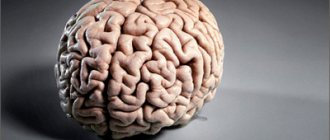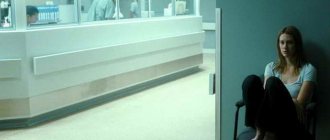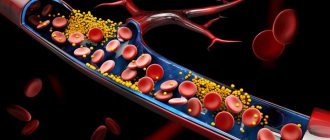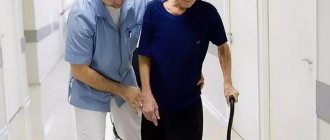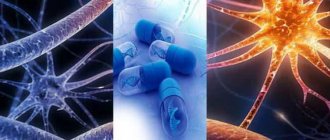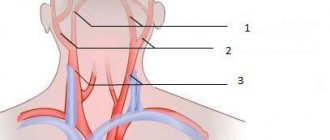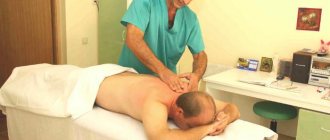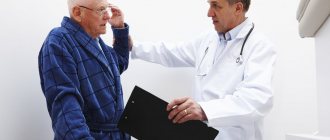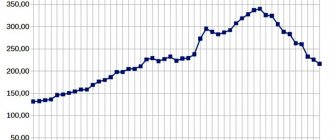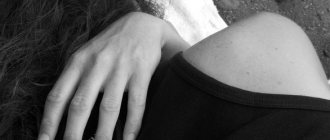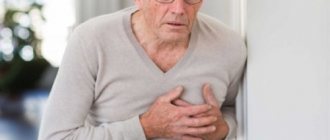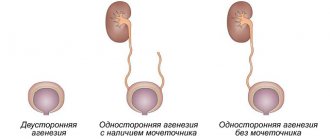Features and symptoms
A stroke can affect different hemispheres of the brain. Depending on which side the violation occurred, right-sided and left-sided brain strokes are distinguished.
Attention! In this disease, if the right hemisphere is damaged, paralysis of the left side of the body occurs, and if the left is damaged, paralysis of the right side occurs, that is, there is a violation of symmetry.
Each hemisphere is responsible for different functions of the human body. Therefore, damage to the left hemisphere of the brain is different from damage to the right. Stroke on the left side of the brain is more common and easier to recognize. It has general and its own special characteristics.
Common symptoms include:
- Severe headache;
- Loss of consciousness;
- Nausea and vomiting;
- Change in breathing;
- Loss of coordination;
- Increased sweating.
Specific symptoms include:
- Speech impairment or loss of ability to speak;
- Incoherent expression of thoughts;
- Hearing impairment;
- Lethargy;
- Distortion of the right side of the face;
- Impaired functioning of the facial muscles on the right side. There is drooping of the corners of the mouth and eyes;
- Numbness on the right side of the face;
- Paralysis of one right eye;
- The right side of the body is paralyzed either completely or partially;
- Possible disruption of the right-sided organs;
- Impaired perception of colors, letters and numbers;
- Aggressive and inappropriate behavior, depression.
Symptoms can vary and vary depending on the severity of the condition. If the above signs of a stroke appear, you should immediately consult a doctor or call an ambulance.
Classification of paralysis
There are two types of paralysis that accompany a stroke:
- Spastic is divided into spinal and cerebral. They lead to immobility of the patient due to impaired motor functions.
- Peripheral paralysis is accompanied by significant changes in the spinal cord. As a result of damage to nerve cells, reflexes fade, muscle tone decreases, or complete muscle atrophy occurs.
- Complete paralysis. Characterized by paralysis of the entire right side of the body. It is a consequence of damage to the pathways, motor nuclei or brain tissue.
Spastic paralysis can combine individual manifestations characteristic of the peripheral type. It occurs due to damage to the left gyrus, located in the vertex area.
Functions of the left hemisphere
The left hemisphere of the brain is responsible for logical thinking and speech abilities.
Thanks to it, people can read, write, remember numbers, letters, names and dates.
This hemisphere is responsible for analysis and logic.
They perceive all facts, recognize numbers and mathematical symbols. The left hemisphere understands only the literal meaning of spoken words. Also here, control is exercised over the opposite side of the body - the right. That is, the left hemisphere is responsible for raising the right hand, and vice versa.
Paralysis concept
Paralysis is a serious change in the body that is characterized by impaired or absent motor abilities. It can be partial (paresis), when only the arms and legs are immobilized, or complete (paralysis), when the entire left side of the body is affected.
Paralysis occurs due to extensive damage to the right hemisphere of the brain. It is what regulates the motor activity and sensitivity of the left side of the human torso. Most often, the pathological process affects the lower and upper extremities and the face.
Prerequisites for brain stroke
There are various prerequisites or, as they are also called, precursors of a stroke.
Harbingers:
- Often dizziness;
- Headaches, most often at night or in the evening;
- Sudden loss of coordination;
- Increased blood pressure;
- Sudden deterioration in speech and memory;
- Numbness in the body;
- Increased sweating;
- Increased blood sugar.
Knowing these prerequisites, you can consult a doctor in time and begin treatment.
Bedsores during paralysis - what is it and how to fight it?
Bedsores are injuries to the skin and soft tissue that occur as a result of poor circulation in a specific area of the body. They are formed where the body comes into contact with a hard surface.
ATTENTION. This state must not be started under any circumstances! It can develop into gangrene when tissues left without nutrition begin to die. As a result, infection and amputation of the upper or lower limbs is possible.
In patients who are malnourished or have severe heart disease, bedsores develop more quickly. The protruding parts of the body are most susceptible to damage. In rare cases, the occipital region or breast folds in women are affected.
To prevent the development of bedsores, it is necessary to carefully monitor the patient. Every 2 hours it is recommended to change the position of his body. To fix the required position, pillows and other similar soft objects are used. It is also important to ensure that the body does not come into contact with the hard surface of the bed.
Be sure to keep your skin hydrated. To do this, you can use various means, for example, sprays, creams. It is necessary to wipe the skin 2 times a day. You also need to massage paralyzed tissues.
The ideal option would be to purchase a special mattress that prevents bedsores. All of the above measures will help avoid adverse consequences that may arise.
Causes
- Critical pressure;
- Tendency to develop blood clots;
- Diabetes mellitus or obesity;
- High cholesterol;
- VSD;
- Chronic smoking or alcohol abuse;
- Arrhythmia;
- Frequent stress and depression.
These factors are the most common reasons why left-sided brain strokes most often occur. You need to better monitor your health and the course of diseases that can lead to the most unfavorable consequences. It is necessary to constantly monitor your blood pressure, experience less stress, etc.
Treatment methods
For paralysis after a stroke, complex therapy is used, including medications, folk remedies, diet, and exercises. The patient must be carefully cared for and monitored.
It is not recommended to leave a person alone. Relatives need to communicate more with the patient and pay attention to him. When paralyzed, a person is forced to lie down for a long time, so it is necessary to ensure that there are no bedsores.
Drug therapy
If the left side is paralyzed after a stroke, doctors prescribe medication. It consists of taking the following means:
- Anticoagulants that thin the blood and improve its clotting.
- Thrombolytics, which prevent the formation of blood clots or dissolve them.
- Neuroprotectors designed to prevent damage to nerve cells in the brain.
- Vitamins for general strengthening of the body.
ATTENTION. Medicines are prescribed exclusively by the attending physician. Taking the above remedies on your own is strictly prohibited. Failure to comply with this rule leads to a worsening of the stroke.
Diet food
If you have a stroke, doctors strongly advise you to adhere to the basic rules of a healthy diet. The patient's diet should contain more fresh fruits and vegetables, dairy products, cereals, lean meat, and fish.
Which case is more dangerous: right-sided or left-sided?
As already mentioned, the left hemisphere is responsible for logic and language ability, but the right hemisphere operates with images, thanks to it people can dream, fantasize, and consider the information received without preliminary analysis.
It is much easier to recognize a stroke in the left hemisphere of the brain than in the right. Based on the impairment of speech and adequate thinking, a doctor or simply a relative will be able to understand that the patient has suffered a stroke. With a right-handed person it is much more difficult to understand.
This is why people with left-sided strokes seek medical help more often and begin the necessary treatment more quickly. But people with right-sided brain damage notice the problem much later, when a significant number of brain cells die and cannot be restored. Thus, we can conclude that a right-sided brain stroke is more dangerous due to late recognition.
Let's consider the difference between the consequences of strokes for the body:
| Left-handed | Right-handed |
| Impaired speech and perception of spoken words. | Memory impairment. A person may forget what he did that day. |
| Paralysis of the right side of the face and body. | Paralysis of the left side of the face and body. |
| Impaired ability to read and write. | Impaired perception and sensation of everything that happens. The patient may feel that his arms and legs do not belong to him. |
| Loss of speech memory. | Hearing and vision impairment. The patient stops correctly assessing distances to objects, etc. |
| Depression and worsening mood. | Depression and passivity. |
What to expect if you have a stroke on the right side of the body?
Stroke on the right side, consequences and treatment, rehabilitation - all this is important to know, because the patient’s future life depends on the speed of providing first aid. Not only doctors should be aware of the symptoms of stroke. Significant symptoms of a stroke include:
- Speech impairment is the first sign. The person speaks slurredly, cannot formulate phrases, does not understand the speech of other people, and cannot pronounce words clearly. In patients who experience paralysis, verbal memory fades. They find it difficult to formulate thoughts and cannot read or write.
- When the right side is paralyzed, a person experiences muscle tension, which leads to a lack of activity in the upper and lower limbs, and it is difficult to smile. If you ask him to stick out his tongue, he either won’t be able to do it, or the tongue is bent.
- Involuntary muscle movements. Often there is simultaneous flexion of the arm and extension of the leg. The hand can be pressed to the body and bent into a fist. Pay attention to the facial muscles. One of the corners of the lips is drooping, and the eyelid is drooping.
- Loss of coordination. A person will not be able to raise two arms in front of him at the same time. One hand down.
These are the main signs of a stroke that everyone needs to know. For a quick diagnosis, just ask the person to do three things - speak, smile and raise their hands straight in front of them.
Treatment
In the hospital, the patient must be connected to a ventilator and all life support functions must be monitored.
Then it is necessary to eliminate all the causes that contributed to the development of stroke , namely: elimination of hemorrhage depending on the type of stroke (ischemic or hemorrhagic), dissolution of blood clots and their systems.
In some cases, surgery is necessary (for example, to remove a blood clot).
Doctors will treat hemorrhagic and ischemic strokes of the left hemisphere differently, since the causes of stroke are different in both cases. In hemorrhagic, there is a strong flow of blood into the brain; in ischemic, on the contrary, there is insufficient blood supply to the brain.
Drug treatment
Includes:
- For hemorrhagic stroke: drugs that strengthen blood vessels, prevent recurrence of hemorrhage (Gordox, Contrical), drugs to prevent vasospasm (verapamil), angioprotectors (Ascorutin), neuroprotectors (Actovegin), etc.
- For ischemic stroke: taking thrombolytics immediately after the onset of stroke (heparin, thrombo ass, aspirin, cardiomagnyl), anticoagulants (nadroparin, dalteparin), vasoactive drugs (Cavinton), anticonvulsants (Depaksin), etc.
- Common medications for both types of stroke: sedatives and hypnotics (phenosipam, tenoten, negrustin, novopassit), venotonics (troxevasin), diuretics and decongestants (indopamite, furasemide, diacarp), headache medications (arlevert), drugs to combat bedsores (Bepanten, Actovegin, Levomekol), etc.
Attention! Most often, hemorrhagic stroke of the left hemisphere of the brain requires surgical intervention.
Physiotherapeutic methods
Physiotherapy is used to improve cerebral circulation and eliminate residual symptoms after a stroke. Most often, for a stroke of the left hemisphere of the brain, the following is used:
- Magnetic therapy is one of the most gentle methods of physiotherapy. Promotes anti-inflammatory and anti-edematous effect, has neurotropic and vasoactive treatment;
- Vibroacoustic therapy - vibration therapy, which dilates blood vessels, reduces swelling, and lowers blood pressure;
- Acupressure - treatment of a disease through a certain point on the body, helps to thin the blood, as well as improve movement;
- Acupuncture is the use of thin needles on certain active points on the human body. Thanks to it, blood flow through the capillaries increases, the nervous state improves, and sensitivity is restored.
Important! Most often, physical therapy is used when the patient is already less weakened.
Physiotherapy
To restore the functioning of parts of the body on the right side, physical therapy is often prescribed.
It is necessary to develop movement and sensitivity of the arms and legs of patients after a left-sided stroke.
Some useful exercises:
- Clench and unclench your hand in a fist.
- Gently raise your hand in front of you, then up, slowly lower it back and repeat this several times.
- Lying on your back, lift one leg up.
- You can also do an exercise for your eyes: alternately open and close.
Breathing exercises
To restore and strengthen the lungs after a stroke, it is necessary to do breathing exercises. A couple of simple exercises will help restore breathing and normalize the functioning of the heart and blood vessels. For example, you can inflate a regular rubber ball; blow air through a tube or pen without a rod; inhale, hold your breath and exhale.
Next we will talk about recovery and possible consequences of a left-sided stroke.
Left-sided hemiparesis after stroke – Doctor
Recovery after a stroke on the left side of the brain is a long process that requires the involvement of both the patient and his relatives, because their support and assistance is very important for the victim.
The term stroke refers to an acute disruption of blood flow in the vessels supplying the brain. Sometimes it is called apoplexy or acute cerebrovascular accident (ACVA).
As a result, part of the nervous tissue dies, and the patient develops focal and cerebral neurological symptoms. The prognosis depends on the age of the patient, the size of the ischemic focus and its location. Stroke is considered a life-threatening condition and patients should be taken to hospital as quickly as possible where they will receive the necessary treatment and care.
Most often, ischemic stroke occurs in patients who are 60–80 years old. The hemorrhagic variant is much more dangerous and entails more serious consequences, but it is less common.
At the same time, the mortality rate is very high - stroke ranks second in the list of the most common causes of death, second only to heart attacks.
Elderly patients usually have the following comorbidities:
- Myocardial infarction.
- Heart failure.
- Atherosclerosis.
- Hypertonic disease.
- Arrhythmias.
- Diabetes.
- Obesity.
Against this background, the rheological properties of their blood are disrupted, and the risk of thrombosis increases. It also leads to dysfunction of the vascular endothelium, which also increases the risk of stroke.
Atherosclerosis itself reduces the patency of blood vessels; in addition, very often blood clots form near lipid plaques in the lumen of the arteries, which over time break off and clog small vessels, including in the brain. The consequences of this are catastrophic.
! Nerve pathways leaving the brain make several crossings. Therefore, left-sided hemiparesis develops with a stroke of the right hemisphere, and, conversely, with damage to the left hemisphere, the right half of the body suffers.
In this case, the patient loses not only the ability to move, but also the sensitivity of the skin in areas innervated by the affected part of the brain. They do not feel temperature or pain, although, at a certain stage, they may, on the contrary, complain of severe burning and tingling in them.
If you suspect a stroke, you need to react quickly. The patient should be placed in a supine position, with the head slightly higher than the body.
Note! It is better to turn your face to the side, as patients often vomit.
The patient should not be given any medications before the doctors arrive, as this may distort some of the symptoms and complicate the diagnosis.
Medical tactics depend on many factors, including the location of the damaged area, its volume, time elapsed from the onset of the disease, concomitant pathology and the patient’s condition. In the early stages, it is possible to use a drug to dissolve the blood clot and restore blood flow, which reduces the likelihood of left-sided paralysis of the body.
At the same time, measures are taken to maintain normal breathing and blood circulation.
Also, drugs to provide neuroprotection are prescribed at an early stage. They allow you to reduce the severity of symptoms and, sometimes, avoid complete paralysis of the patient.
Further prognosis depends on the location and size of the damaged lesion, the presence of cerebral edema and concomitant pathology. Unfortunately, approximately 60-70% of patients experience motor dysfunction and, less commonly, paralysis. To achieve the most complete recovery of a person after a stroke, you need to take treatment and rehabilitation measures responsibly.
An interdisciplinary approach occupies an important place in it. Several specialists are involved in the treatment of such patients - a speech therapist, a physiotherapist, an occupational therapist, a massage therapist, a rehabilitation specialist, and a neurologist. The patient needs:
- Restore the ability to swallow and speak.
- Adapt to new living conditions, learn to take care of yourself in everyday life.
- Resume motor functions in the affected limbs as much as possible.
Despite the fact that with a left-sided stroke, an entire section of the nervous system dies, the brain has the ability to restore lost functions by creating new neural connections between surviving cells. It is called neuroplasticity, and it is based on the process of forming new information chains. Rehabilitation measures are aimed specifically at activating this process.
Therefore, to reduce recovery time and achieve the best results, it is necessary to perform regular and carefully selected exercise programs.
In fact, a person re-learns the necessary skills, simultaneously developing the muscular system. It is important to perform many repetitions of each exercise to improve your results.
In addition to physical training, auxiliary techniques are also used in the form of medications, therapeutic exercises and exercises with positive feedback.
It is important! Breathing exercises are very useful to prevent the development of congestion in the lungs due to prolonged inactivity and blood stagnation.
At the initial stages of rehabilitation, it is impossible to say for sure whether the consequences of a stroke will pass or will remain forever. Recovery time must be taken into account.
Therefore, it is at this time that you need to be most attentive to a patient with damage to the left side of the body.
The exercises should be continued after the patient is discharged home. Doctors note that massage of the affected limbs is of great importance.
The bed of such patients should be flat, clean and dry. It is useful to attend physical therapy sessions regularly.
In addition, you need to pay as much attention as possible to psychological assistance to patients. It is necessary to help them accept what happened, set them in a positive mood and involve them in the rehabilitation process.
This will help achieve much better results during recovery, especially at home.
This also helps people overcome depression, neurosis or other psychological consequences that often accompany stroke patients.
For a better result, the combined efforts of both the patient himself, his relatives, and a team of specialists in matters of rehabilitation are required.
It should be approached as responsibly as possible, because it is regular and fully performed exercises that allow the brain to re-create lost neural connections.
Patients should not despair, because if the acute period has passed without complications, then the worst is over. If you follow the recommendations of doctors and the right lifestyle after a stroke, they are normally rehabilitated and live for many years.
ISCHEMIC STROKE. BRAIN HEMORRHAGE (How to live after a stroke? Doctor's advice) Stroke. Rehabilitation after a stroke. Complex treatment. Where? How? Hemorrhagic stroke. Brain hemorrhage
Source: https://venvaricoz.site/gemiparez-levostoronniy-posle-insulta/
Recovery and rehabilitation
The effectiveness of a patient’s recovery after a stroke on the left side of the brain largely depends on how quickly first aid was provided. Recovery from a stroke is quite possible at any age, the main thing is good care and compliance with all the doctor’s instructions and recommendations.
After discharge from the hospital, the patient is under the supervision of a neurologist. It is also necessary to take some medications to strengthen the body. All these drugs are prescribed by a doctor depending on the condition.
Physiotherapy
Physical education and breathing exercises for recovery also play a big role. After a stroke of the left hemisphere of the brain, patients can study independently or with the help of loved ones and relatives. It also depends on how strong the body is. At first, it is advisable to monitor the patient’s activities and help him with them.
Speech restoration
Moral support is also very important here.
It is necessary to communicate more with the patient, ask him questions so that he can answer.
If speech functions have not been restored after treatment, then you need to invite a speech therapist to the patient so that he can work with him and re-teach him to speak and think well.
Hirudotherapy
Hirudotherapy is often used in the prevention of recurrent stroke and recovery . This therapeutic method , including hirudin (an anticoagulant), enters the blood It helps dissolve blood clots and improve blood circulation. Usually leeches are placed behind the ears or in the tailbone area.
Massotherapy
To restore motor activity of the right side of the body, the patient is given a therapeutic massage. It is necessary to carry it out for 5 minutes at first, then increase the time to 30 minutes. The massage should be performed by a specially invited massage therapist who knows all the necessary nuances and basics of therapeutic massage after a stroke. Massage helps thin the blood, reduce tone, and prevent bedsores.
Special diet
Not least important is a special diet with a reduced amount of cholesterol, which causes blockage of blood vessels and the appearance of plaques, which subsequently leads to the formation of blood clots.
Food products that can be eaten: citrus fruits, spinach, mustard, berries, nuts, corn, vegetables, dried fruits, tomato paste, fruits, wheat bran, sea fish, seaweed, freshly squeezed juices, etc.
Products that need to be excluded from the diet: smoked, salted, canned, fatty and rich broths, sausages and frankfurters, milk and everything made from it, sweets and flour products, processed foods, fast food, soda, ice cream, strong tea and coffee, semolina, etc.
Doctors advise eating foods that contain vitamin E. You can also take this vitamin in tablets. It reduces the risk of recurrent stroke.
Getting rid of bad habits
It’s hard to get rid of bad habits, but it’s necessary for your health.
After a stroke, the patient is prohibited from drinking alcohol and smoking.
Not only family and friends should control this, but the patient himself needs to realize the significance of this step for his own health.
Possible complications
The consequences of a stroke are sometimes quite serious and even irreversible. This:
- loss of appreciation of cause-and-effect relationships and the ability to think logically;
- lethargy, difficulty perceiving reality;
- complete loss of speech function;
- immobility leading to the formation of bedsores and the development of pneumonia;
- helplessness provokes the development of isolation and depression.
Timely treatment can minimize the development of severe complications of the disease and prevent the possibility of death.
It should be remembered that recovery from paralysis caused by a stroke is a long process. It may last not a month, not a year, but even several years. However, strict adherence to medical recommendations, giving up bad habits, following a diet and reasonable physical activity give a chance for complete rehabilitation.
Stroke is a serious disease caused by impaired blood circulation in the brain. It can be ischemic or hemorrhagic. One of the complications of the pathology is paralysis of the left side of the body. Why does it occur and how to get rid of it?
Consequences
What should you expect if you do not see a doctor on time or do not comply with the indicated treatment? Such negligence towards one's health can lead to complicated consequences of a stroke.
These include:
- Poor speech or lack thereof;
- Facial asymmetry on the right;
- Difficulty in movement and articulation;
- Convulsive movements;
- Difficulty in perceiving and analyzing situations;
- Difficulty accepting new information;
- Permanent depression;
- Reduced learning functions;
- Complete or partial paralysis.
Early complications of stroke cause death within a month for 25% of patients. It is necessary to follow all the doctor’s instructions and prescriptions in a timely manner so as not to trigger the disease.
Forecast and what are the chances of survival
It is impossible to say exactly how long patients live after suffering from the disease.
The prognosis for life and the chances of survival are individual for each patient who has suffered a stroke of the right hemisphere.
It all depends on how quickly treatment is started and how many brain cells are affected.
After all, the more neurons affected by the stroke, the more difficult it is for the patient to recover.
One third of patients die in the first month after the onset of the disease. A poor prognosis awaits older people and people with chronic diseases. For young people, the chance to recover and recover is several times greater, since their body is stronger and many chronic diseases that already exist in old age are absent. In 30% of cases, the disease can recur after a while.
Survival after a stroke within a year is almost 70%, within 5 years - about 50%, within 10 years - 25%.
What types of strokes are there?
What are the chances of recovery with a stroke on the right side? To answer this question, you need to know the type of stroke and how quickly help is provided. The prognosis for recovery depends on these things.
Types of strokes
There are two types: ischemic and hemorrhagic. Ischemic (lacunar) stroke is a blockage of a vessel by a blood clot, which is formed due to the accumulation of cholesterol plaques. The root cause of this condition is atherosclerosis. This is a disease of blood vessels that are susceptible to the negative effects of bad cholesterol. It is this substance that depletes the walls of blood vessels, making them brittle and fragile. The causes of this type of stroke are frequent arrhythmia, high blood clotting, and tachycardia. The condition can develop from 2 hours to a day.
Hemorrhagic stroke develops as a result of high blood pressure or due to congenital vascular pathology. Hypertension leads to increased blood flow, the main cause of vessel rupture.
Prevention of relapse
The prognosis if the left side is paralyzed after a stroke may be different. The chance of recovery depends on the degree of damage, the age of the patient, the presence of concomitant pathologies and other factors. Therefore, each situation is strictly individual.
The older a person is, the higher the likelihood of a recurrent stroke with paralysis of the left side of the body. Most patients are repeatedly affected by this pathology, but not all of them survive. Therefore, the patient should do everything to prevent a relapse.
Preventive measures are:
- Proper nutrition. It must be followed to avoid excess weight gain and clogging of blood vessels with cholesterol plaques - atherosclerosis.
- To live an active lifestyle. It is advisable to walk for 20–30 minutes every day.
- Blood pressure control. It is necessary to regularly measure your blood pressure and take pills to normalize it.
- Avoid stressful situations.
- Regulate the amount of sugar and cholesterol in the blood.
- Stop drinking alcohol and smoking.
Paralysis of the left side after a stroke is a serious consequence that requires immediate intervention by medical personnel. Recovery of the body takes a long time and requires a lot of strength and patience.
In acute cerebrovascular accident, a stroke occurs. The right side can be paralyzed when ischemia or hemorrhage develops in the left hemisphere of the brain. If a stroke occurs, paralysis of the right side is manifested by impaired muscle function. Patients also experience changes in sensitivity on the right side. Patients with stroke are hospitalized at the neurology clinic of the Yusupov Hospital around the clock.
Why does the disease occur?
In the case of the development of paralysis during a stroke, various diseases act as unfavorable factors. The list of possible reasons includes:
- arterial hypertension in case of uncontrolled flow;
- atherosclerotic changes in the vessels of the brain or vessels of the cervical spine;
- some diseases of the heart and blood vessels;
- suffered a severe stressful situation, as well as as a consequence of a hypertensive crisis.
The cause of the disease may be the presence of certain problems with blood clotting, certain endocrine disorders. Stroke is often diagnosed in people with global capillary damage; the risk of its occurrence is increased by a sedentary lifestyle and taking hormonal medications.
Irreversible changes in the cerebral cortex and its trunk also occur during prolonged oxygen starvation.
When the lesion is located in the left hemisphere of the brain, symptoms appear on the right. A speech disorder is considered a dubious sign, since it mainly affects left-handed people.
How does rehabilitation work after paralysis?
After treatment for paralysis, the patient needs to go through a long road of rehabilitation. It is impossible to indicate the exact period of recovery of the body, since this is strictly individual, depending on the general condition of the patient, the extent of brain damage, and any disorders that have arisen. Many patients permanently lose their ability to work, becoming disabled.
One of the main goals of rehabilitation after paralysis is the restoration of motor function. The main measure to achieve this goal is therapeutic exercises. The complex is developed by a specialist for each patient separately. It usually includes exercises with flexion and extension movements of joints, rotation, and muscle stretching.
Correction of movement disorders
Treatment for paralysis of the left side of the body after a stroke includes exercise therapy, massage, and physiotherapeutic procedures. It is necessary to start performing these activities as early as possible. Of course, taking into account the patient's condition.
In the first days after a stroke, bed rest is required. It is important to take measures to prevent bedsores and the occurrence of congestion in the vessels of paralyzed limbs. The patient should not remain in one position for a long time. It is important that he lies not only on the healthy side, but also on the paralyzed side. The affected limbs should be placed in the correct position. This is done to prevent compression of blood vessels and nerves, as well as to prevent the development of contractures. Central paralysis is characterized by muscle hypertonicity, which must be treated, otherwise the prognosis for the return of motor functions will be unfavorable.
Treatment by position:
- Lying on your back. The left hand is taken to the side, extended, fingers spread. The position of the left leg is different: the limb is slightly bent at the knee, the foot is at a right angle in relation to the shin.
- On the healthy side. The arm is bent at the elbow and shoulder joints, the leg at the hip and knee. Pillows are placed under the limbs.
Giving the patient a special position in bed
- On the side of paralysis. Position of the left arm: extended forward, extended. The left leg is slightly bent at the knee.
The correct position of the patient in bed should be constantly monitored and changed every 2 hours
In case of severe spasticity, treatment with muscle relaxants (Mydocalm, Sirdalud, botulinum toxin) is prescribed.
Paralysis of the left side is also corrected with the help of exercise therapy and massage. You should start with passive gymnastics, when all the movements are made not by the patient, but by the instructor. Later, when the patient regains the ability to move, he needs to be encouraged to perform independent exercises.
Treatment of paralysis of the left side of the body after a stroke involves teaching the patient movement and self-care skills. They usually start gradually. First, the patient is taught to sit up in bed, then to stand up, and only then to walk.
Restoration of movement of the limbs on the left side occurs unevenly. It is difficult to restore fine motor skills and it is not always possible to achieve the previous volume and dexterity of movements. After a stroke, it is necessary for the patient to do special exercises with his left hand: assemble mosaics, puzzles; fingered small objects.
Sensorimotor simulator for rehabilitation after stroke
Massage is another important component, without which treatment of the consequences of stroke will be ineffective. It improves blood flow in paralyzed limbs and reduces muscle tone, which is very important for the prevention of contractures.
The main methods of treatment for paralysis or paresis are exercise therapy, massage, physiotherapy (magnetic therapy, ozokerite, electrophoresis, electrical stimulation, biomechanics).
Consequences and treatment of stroke on the left and right side
Left- and right-sided stroke manifests itself differently. The consequences are also different. This is due to a certain location in the brain of areas responsible for certain functions of the body: speech, vision, touch, imaginative thinking, etc.
The right hemisphere is responsible for perceiving the world around us and processing information entering the brain through receptors from the senses. For left-handers, the speech center is located in the right hemisphere.
The left hemisphere is dominant in most people. This is associated with a more severe course of left-sided stroke. Some functions are duplicated by both hemispheres. This is sensitivity of all types: tactile, pain, temperature, spatial. The functions of vision, smell, and hearing are also duplicated, since they have paired organs. This also applies to motor activity, but each hemisphere of the brain is responsible for the movement of the back of the body.
With a right-sided stroke, paralysis of the left side of the body occurs to varying degrees of severity. The ability to speak is lost (or speech becomes incoherent). The patient begins to have problems with memory, he cannot always remember words, and does not perceive other people's emotions. Behavior becomes cautious and inhibited.
When a left hemisphere stroke occurs, the right side of the body is paralyzed. Orientation in space is lost. Memory lapses affect motor and system memory more. The person becomes more impulsive and hot-tempered. He loses his speech, writing and reading skills, becomes unable to learn new things and analyze incoming information.
Strokes are divided into ischemic, which are based on blockage of a vessel, and hemorrhagic, in which hemorrhage occurs in the brain.
For diagnosis, CT and MRI of the brain, ECG of the heart, ultrasound, general and biochemical blood tests, and chest X-ray are performed. Drug treatment is used, and in some cases emergency surgery is performed.
Treatment depends on the type of stroke. Universal measures for any damage of this kind are to maintain the functioning of vital organs and systems, normalize blood pressure, restore nerve cells, and relieve brain edema. For ischemic stroke, the goal of treatment is to dissolve blood clots, reduce blood clotting, remove cholesterol plaques and prevent the formation of new ones.
